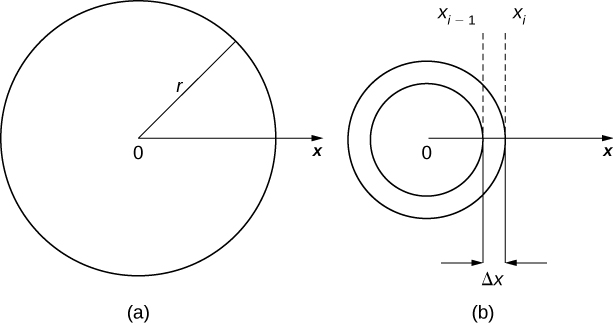Mass and Density Cont.
Mass–Density Formula of a Two-Dimensional Disk
We now extend this concept to find the mass of a two-dimensional disk of radius [latex]r.[/latex] As with the rod we looked at in the one-dimensional case, here we assume the disk is thin enough that, for mathematical purposes, we can treat it as a two-dimensional object.
We assume the density is given in terms of mass per unit area (called area density), and further assume the density varies only along the disk’s radius (called radial density). We orient the disk in the [latex]xy[/latex]-plane, with the center at the origin. Then, the density of the disk can be treated as a function of [latex]x,[/latex] denoted [latex]\rho (x).[/latex] We assume [latex]\rho (x)[/latex] is integrable.
Just as we did with the one-dimensional rod, we need to partition the interval. Partition the interval [latex][0,r][/latex] into [latex]n[/latex] segments, each of width [latex]Δx[/latex].

We now approximate the density and area of the washer to calculate an approximate mass, [latex]{m}_{i}.[/latex] Note that the area of the washer is given by
You may recall that we had an expression similar to this when we were computing volumes by shells. As we did there, we use [latex]{x}_{i}^{*}\approx ({x}_{i}+{x}_{i-1})\text{/}2[/latex] to approximate the average radius of the washer. We obtain
Using [latex]\rho ({x}_{i}^{*})[/latex] to approximate the density of the washer, we approximate the mass of the washer by
Adding up the masses of the washers, we see the mass [latex]m[/latex] of the entire disk is approximated by
We again recognize this as a Riemann sum, and take the limit as [latex]n\to \infty .[/latex] This gives us
We summarize these findings in the following theorem.
mass–density formula of a two-dimensional disk
Let [latex]\rho (x)[/latex] be an integrable function representing the radial density of a disk of radius [latex]r.[/latex] Then the mass of the disk is given by
Let [latex]\rho (x)=\sqrt{x}[/latex] represent the radial density of a disk. Calculate the mass of a disk of radius [latex]4[/latex].